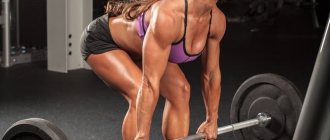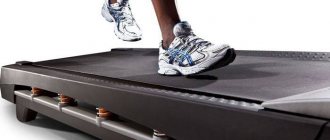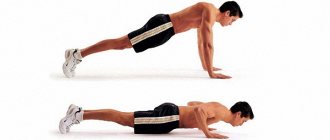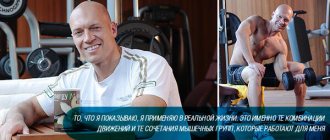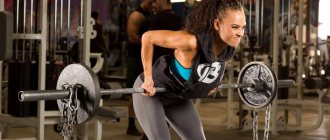Not only does a toned back look amazing, it helps the athlete achieve his goal, makes everyday life much easier, protects the spine and improves posture!
Knowing how to pump up your back is the sacred duty of every athlete and athlete, regardless of the type of sport: pumped up back muscles are equally necessary for powerlifters, swimmers, martial artists and especially bodybuilders.
There's nothing more stunning than well-developed back muscles that curve like roads on a map: broad dorsals like jet wings and lower back muscles.
Who needs to pump up their back muscles?
Back training is important for many reasons: pumped up back muscles will immediately make you stand out from the crowd of athletes, because only a real bodybuilder can work out the “wings”. Your body will look harmonious and balanced.
There is nothing you can do in martial arts without a strong back: your stabilization depends on the strength of your muscle corset. The back is the frame that holds all the muscles and unites the efforts of the whole body. Weak back muscles cannot properly perform their stabilizing role, and problems may arise in maintaining an upright posture. In wrestling, pumped-up back muscles make it easier to perform throws with body extension.
Powerlifters also strive to effectively pump up their backs: in powerlifting, this is the key to success in performing deadlifts, one of the competitive disciplines of powerlifting.
Why is it not easy to work out your back?
In addition, by pumping up your back muscles, you will significantly make your daily life easier, because we perform most of the functional movements, for example, carrying heavy objects, on our backs.
From a medical point of view, developed back and core muscles help maintain correct posture and spinal alignment, which has a positive effect on the vital organs of the abdominal cavity. You see how important it is to train your back, are you ready to train?
If you are already in the gym and ready to start, we recommend 2 programs from our training videos. Further in the article you will find several more program options.
The first training option is about how to pump up your back. In this video you will learn how to pump up your back, what exercises to do to pump up your latissimus dorsi muscles. Perform these exercises in three sets of eight repetitions each.
- Lying latissimus dorsi stretch
- Chest row on the upper block 3x8
- Pull-ups with deviation 3x8
- Reverse grip lat pulldown 3x8
- Wide-grip lat pulldown 3x8
In the next video you will learn the second training option for the back muscles.
You will understand the maximum understanding of what works for you and your body in pumping your back in the gym only after you start trying different exercises.
- Lower back stretch with lunge and twist 2x5
- Standing mid-back stretch (with body rotation) 2x5
- Rows to the waist on the simulator in support 3x8
- Pullover on a 3x8 block
- Bent-over barbell row 3x8
- Shrugs with dumbbells 3x8
The importance of back training
However, many people ignore the importance of this muscle group. The main reason for this is complexity, because it is quite difficult to feel how the back muscles work. The secret is to start all exercises using not only your arms, but also your back muscles.
How to pump your back if you still have problems? Use special hooks for lifting. This will reduce the stress on your biceps, putting more pressure on your back.
Note that this is about using enough weight, not too much. Train hard, but not so hard that you cheat to lift the barbell up, which is guaranteed to disable the muscles from the movement.
Another reason for a weak back is that people simply train with insufficient weight. If you need to make your muscles more massive, use more weight in your “pulling” exercises.
If you really want to pump up a wide back, do a good job of deadlifting.
Strengthening your back muscles in the gym
If you want your back to be wide and powerful, you definitely need to pump up those awesome latissimus dorsi muscles so that your wings are so big that you can't close your arms.
Perfect for this :
- pull-ups,
- bent over row of barbell or dumbbells,
- pull of a vertical block to the chest.
These exercises will help strengthen almost all the major back muscles, such as the latissimus, rhomboids, trapezius and teres major.
If your goal is to focus on the middle of the back , then horizontal rows are more suitable for you. For example:
- bent over barbell row,
- dumbbell rows to the waist while lying on a bench,
- T-bar pull,
- horizontal thrust in a hummer or in a block.
These exercises work the trapezius and rhomboids more, as well as the latissimus muscles closer to the spine.
To pump up your upper back , you need to do a variety of shrugs with dumbbells or a barbell; pulling the barbell to the chin is also a good way to engage the trapezius muscle.
The lower back can be worked well with hyperextension and deadlifts, and you can also do the boat exercise. You need to have a strong lower back at least to protect your spine.
And now I’ll give an example of a program that uses all the back muscles and pumps it up in all hard-to-reach places, every corner will receive a load:
- Wide-grip chest pull-ups, 4 sets of 8-10 reps.
- Bent-over barbell rows 4 sets of 8-10 reps.
- Rows of a horizontal block to the belt 3 sets of 10-12 times.
- Pullover with dumbbells 3 sets of 10-12 reps.
- Shrugs with dumbbells 3 sets of 10-12 reps.
- Hyperextension 3 sets of 10-12 times.
Rest between approaches should be at least a minute , and preferably 1.5-2 minutes. You need to regularly increase weight and progress. But on the condition that you feel exactly the back muscles.
Human back: anatomy
Knowing muscle function is critical when designing a workout and understanding proper technique. With that in mind, let's take a look at the anatomy of the back:
Trapezius muscle
It is a very wide, triangular-shaped muscle that covers almost all the muscles in the back of the neck and large part of the back. It originates in the occipital bone at the base of the skull and enters the shoulder blades and collarbones. The fibers of this muscle ensure its stretching in three directions: up, down and inward. The functions of the trapezius muscle are to turn the head and raise the shoulders.
Many people work the trapezius muscle along with the shoulders, and this is a great method, however, in this article we will include the trapezius muscles in the back.
<Rhomboid minor/major muscles
The rhomboid muscles begin on the spine and attach to the middle of the shoulder blades. Their function is to bring the shoulder blades towards the spine.
Teres major muscle
This muscle originates on the outer edge of the scapula and attaches to the humerus. Its function is to stretch the arm back.
Latissimus dorsi muscles
These are the largest muscles of the back. Large, V-shaped and pumped, they provide back strength. The latissimus muscle attaches to the upper end of the humerus and runs down the spine and pelvic girdle. The function is to pull the arm down, and, if the arm is in a fixed position, to help pull the arms up.
Erector back muscles
The main function of these muscles is to support and stretch the spine. This group includes the following muscles: longissimus, spinalis and iliocostalis.
As you can see, working the back muscles, the anatomy of which has so many nuances, is quite difficult. However, there are two main types of movements that help tone your back: rowing movements and downward movements.
In addition, there are strength training movements such as deadlifts, snatches, and power cleans. These exercises work much more than just your back - thanks to them, you involve and pump up your whole body! These compound movements cause a dramatic natural increase in the amount of anabolic hormones in the body such as testosterone and growth hormone.
How to properly pump up your back
Although many people train their chest and back on the same day—by the way, Arnold did just that—it makes sense to train your back on a strictly designated day. It is especially worth paying attention to this method for those whose back is a weak point.
Then, if you want, you can train your biceps and develop your forearms. This will allow you to focus all your energy on working your back instead of “sharing” energy with the other large pectoral muscle group. Since the biceps are actively involved in all back exercises, it makes sense to train them after the back. It's a good idea to include forearms in this workout,
However, there is a theory that the forearms, like the abdominal muscles, need to be worked more often than others. These muscles have high endurance and are involved in every exercise performed (after all, you need a grip to hold the barbell), so work them hard no more than once a week along with your biceps.
The main thing is that you feel how the training works for you. Before going to the gym again, just make sure your muscles are fully recovered. Remember, growth only happens if you have enough recovery, not because of how many hours you spend in the gym every day.
Back muscle workout #1
Deadlift
- 5 sets of 15,12,10,8,6 repetitions
- Body part: Quadriceps Equipment: Barbell
Pull-ups
- 1 set of 25 reps
- Body Part: Lat Equipment: Bodyweight
Note: If you can do that many pull-ups in one set, do two sets of 25 reps. Use a wide overhand grip and full range of motion
Bent-over barbell row
- 3 sets of 12 reps
- Body Part: Press Equipment: Barbell
Note: Use a weight that you can lift for 8 reps. Rest and then complete the set.
Add to Calendar * Add to My Workouts * Print Workout
* — The service is in beta testing
To properly tone your back muscles with this workout, remember this: your deadlift should be sharp and active, but completely controlled, and slow on the downward movement. Use a full range of motion when doing pull-ups, concentrating only on your back and not your biceps. Remember that your biceps are just hooks, nothing more.
Features of back muscle training
As you can see, the size of our rear muscles is very large, which means that the load on the back must be significant. To pump up your back, you need to work with extreme weights and not be afraid of exercises such as pull-ups, deadlifts and bent-over barbell rows. Yes, they are complex, but in turn, they are also very effective! Due to the use of large weights, the volume of training should decrease, so the number of repetitions in a set should be in the range of 6-12 times.
You should also understand that the back muscle group is very large, and it will not be possible to fully pump it up in one workout. Therefore, similar to leg training, the back should also be divided into two workouts per week. On the first we train the upper back, and on the second the lower and middle parts. Moreover, the rest time between these workouts should be at least 3 days. Pull-ups and lat pull-downs are perfect for upper training, as mentioned above. The lower back and middle part are best trained with deadlifts and various variations of horizontal rows to the waist.
The experience of many professional bodybuilders has noted that the back muscles respond better to the load if the positive part of the exercise is performed in an explosive style. This means that, for example, when performing pull-ups, the upward movement must be performed as quickly as possible, applying the most powerful effort to this, but the lowering must be emphasized slowly. But don’t confuse the explosive style with jerks and technical violations. The positive phase should be powerful, but at the same time, remain strictly technical.
The next very important point in training the back muscles. You need to learn to turn off your biceps from work! Yes, in every back exercise, in addition to the target muscles, the biceps of the arms also work. It is clear that due to their size, they have a much harder time than the back muscles. How to pump up your back if your biceps get tired ahead of time? The entire training of the same widest muscles will come to naught, since they will not receive the load necessary for growth. The solution to this problem is to mentally connect the brain with the back muscles. During exercises, try to feel the load in the lats, not in the biceps. This will not happen right away, but with each workout you will feel the load in the target muscles better and better. It will also help that the wider the grip, the less strain on the biceps.
A few words about grip width. In any pulling exercise for the back, you can vary the grip width from narrow to wide. But what is the peculiarity of each? It's simple. The narrower the grip, the greater the range of motion and the greater the load on the biceps. The wider the grip, the correspondingly less amplitude of movement, less load on the biceps and more on the lats. Beginners should start with a wide grip. As you learn to “turn off the biceps from work,” the grip can be gradually narrowed, down to the narrowest, in order to work the lats more deeply. In general, a medium grip would be optimal.
Back muscle training No. 2
Deadlift in a power rack
- 5 sets of 15,12,10,8,6 repetitions
- Body part: Lower back Equipment: Barbell
Smith Machine Bent Over Row
- 3 sets of 8 reps
- Body part: Middle back Equipment: Exercise
Pull-ups
- 4 sets of 10 reps
- Body Part: Lat Equipment: Bodyweight
Attention: 2 of these approaches are with a medium wide grip on top, and 2 with a wide grip
Shrugs with a barbell
- 4 sets of 12,10,8,6 repetitions
- Body part: Trapeze Equipment: Barbell
Note: All are working, so use a weight that will allow you to complete the required number of repetitions.
Add to Calendar * Add to My Workouts * Print Workout
* — The service is in beta testing
Power cleans are a sharp exercise. Be sure you understand this feature of the exercise and always keep your reps under control. The cable row should be performed with continuous tension: contract the muscles and count to 3 as you lower the weight to your chest. If possible, reverse the movement, counting to 4.
Use the same repetition method during lat pulldowns. When performing shrugs, pull your shoulders up towards your ears, hold and contract the muscles, work this way in any strength training in the gym, not just when pumping up the back muscles.
Lower back muscles
Another problem in working out the back is strengthening the lower back. Few athletes pay due attention to this department. A weak lumbar region will not allow you to perform deadlifts and will cause the development of pain in the spine.
Exercises such as hyperextension should be present in your sports program. It is better to work your lower back after a warm-up workout. These exercises will bring the same result as the plank for working out the abs. They are aimed at developing the corps. But remember, when performing exercises, technique is more important than the number of repetitions.
Workout for the broad back muscles No. 3
Pull-ups
- 1 set of 30 reps
- Body Part: Lat Equipment: Bodyweight
Note: 30 reps for as many sets as needed. If you can do that many pull-ups in one set, do two sets of 30 reps. Use a wide overhand grip and full range of motion
Pull-down of the upper block behind the head
- 2 sets of 8 reps
- Body part: Lat Equipment: Block
Smith Machine Bent Over Row
- 3 sets of 12 reps
- Body part: Middle back Equipment: Exercise
Standing dumbbell shrugs
- 4 sets of 12,10,10,8 repetitions
- Body part: Trapeze Equipment: Dumbbells
Add to Calendar * Add to My Workouts * Print Workout
* — The service is in beta testing
As you deadlift, pull the barbell toward your upper chest. In this and the next exercise, maintain continuous tension for the best back training. Pause and contract the muscles at the peak of the movement, counting to 3. When doing the T-bar row, move up sharply, move down slowly and in a controlled manner.
Examples of workouts
Below we will consider combinations of exercises depending on physical fitness.
Complex back training once a week. Advanced level
- Wide grip pull-ups.
- Lever pull with a narrow grip.
- Pull of the upper block behind the head.
- Horizontal block thrust.
- Pull the upper block with straight arms.
- Hyperextension.
Split training: back - chest. Average level
- Head pull-ups.
- Barbell row to the waist.
- Bent-over row with one dumbbell.
- Bench press.
- Dumbbell press at a 45 degree angle.
- Reduction of arms in the simulator.
Split workout: back - biceps. Low and medium level
- Pull of the upper block to the chest.
- Pull the upper block behind the head.
- T-bar row.
- Horizontal pull to the waist.
- Curling arms with a barbell.
- Curling arms with dumbbells with supination.
And also read: 5 static exercises for the back → Back exercises with dumbbells → 7 exercises with kettlebells for the back →
Workout for thickening back muscles #4
Deadlift
- 6 sets of 15,12,10,6-8,6-8,4 repetitions
- Body part: Quadriceps Equipment: Barbell
Bent-over dumbbell row
- 3 sets of 8-10 reps
- Body part: Middle back Equipment: Dumbbells
Bent-over barbell row
- 3 sets of 8 reps
- Body Part: Press Equipment: Barbell
Pull-ups
- 3 sets of 10 reps
- Body Part: Lat Equipment: Bodyweight
Shrugs with a barbell
- 3 sets of 15 reps
- Body part: Trapeze Equipment: Barbell
Add to Calendar * Add to My Workouts * Print Workout
* — The service is in beta testing
When deadlifting, use a heavier weight than usual. Move up sharply, stay at the peak for three counts, and only then slowly lower down.
In the bent over dumbbell row the pattern is similar. The features of pull-downs and push-ups here are as follows: maintain constant tension, and count to 5, hold at the peak. Stop with these two exercises halfway through each repetition and pause briefly for another 5 counts.
Back training - order of exercises
Training the back (like any other large muscle groups) should begin with a warm-up - this is necessary to activate the muscles and their more complete involvement in the work when performing the main exercises of the program. In the case of the back, the purpose of the warm-up is to activate the latissimus dorsi muscles.
Actually, the main secret to pumping up your back is the ability to consciously involve certain parts of it in work. When doing pull-ups or pull-downs, you should feel your lats; when performing deadlifts or bent-over rows - the middle of the back; when performing shrugs - trapezoids.
// Back day - order of exercises:
- warm-up and muscle activation – 5 minutes
- pull-ups - 3-4 sets, maximum number of repetitions
- deadlift - 3-4 heavy sets, 6-8 reps
- 1-2 exercises for the upper back - for example, lat pulldown
- 1-2 exercises for the middle of the back - for example, barbell or dumbbell rows
- 1-2 trapezius exercises - for example, shrugs
- cool down and gentle stretching – 5 minutes
// The best back exercises are in the gym
A history of fractures (as well as any other musculoskeletal injuries or chronic diseases) places limitations on exercise selection and training strategy - please consult with a specialist.
Number of approaches and repetitions
Most often, it is believed that to fully pump a large muscle group (for example, the back), 15-20 total approaches of strength exercises are sufficient. However, these can be either 4 exercises of 4-5 approaches each, or 8 exercises of 2-3 approaches each.
The number of repetitions in the approach depends on the working weight. Deadlifts are performed with relatively heavy weights (and perfect form)—and low reps. Back exercises in simulators and exercises with dumbbells are performed in 8-12 repetitions, exercises on the trapezius - in 12-15 repetitions.
If you train 4 or more times a week, and devote a full day to your back, the total training duration should be about 60 minutes. If you train at the gym 3 times a week, train your back for about 40-45 minutes, and train your arms or shoulders for the remaining 15 minutes.
// How to properly pump your back - and which muscles to combine in one day?
Back strength training #5
Forward bends with a barbell on the shoulders “Good morning”
- 5 sets of 15,12,10,8,8 repetitions
- Body part: Hamstrings Equipment: Barbell
Deadlift
- 4 sets of 12,10,8,6 repetitions
- Body part: Quadriceps Equipment: Barbell
Standing one-arm dumbbell press
- 4 sets of 8,8,6,6 repetitions
- Body part: Shoulders Equipment: Dumbbells
Add to Calendar * Add to My Workouts * Print Workout
* — The service is in beta testing
Every time you pump up your back muscles with a workout like this, you really work your whole body. Try it and you will notice a huge natural hormone production as a result of training.
For the main sets of these workouts, use heavy weights and keep the reps firm but controlled and smooth on the way back.
conclusions
Try these 5 workouts or other specific programs for a wider back or exercises to strengthen your back. If your goal is to lose weight, we recommend that you pay attention to exercises for losing weight on your back.
Be sure to warm up before training and stretch your muscles after to avoid soreness.
There is no shame in not knowing the technical nuances of execution if you are willing to learn and improve. It is much more dangerous to perform an exercise with the wrong technique, ignoring the recommendations of instructors. At a minimum, this means a waste of time and energy, and at a maximum, it is fraught with herbs. You must check and hone your technique.
Make sure you understand how each exercise is performed correctly. If you have doubts about the technique, refer to the description of all back exercises in the base, ask a question to an expert or your trainer.
Taking sports supplements - creatine, arginine, intra-workout, bcaa amino acid and pre-workout complexes will help you increase your strength.
Sports nutrition is specifically formulated to improve sports and fitness performance for men and women. Just add it to your diet and go ahead to conquer new heights!



